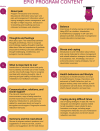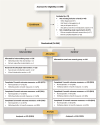Living well with chronic pain: a 12-month randomized controlled trial revealing impact from the digital pain self-management program EPIO
- PMID: 38962688
- PMCID: PMC11221858
- DOI: 10.1097/PR9.0000000000001174
Living well with chronic pain: a 12-month randomized controlled trial revealing impact from the digital pain self-management program EPIO
Abstract
Introduction: Chronic pain affects a wide range of physical and psychological aspects of life for those impacted. Psychosocial treatment approaches may be of support, but outreach is still limited.
Objectives: To evaluate the efficacy of EPIO, an evidence-informed, user-centered digital self-management intervention for people with chronic pain, in a 12-month randomized controlled trial.
Methods: People living with chronic pain (N = 266) were randomized to the EPIO intervention (n = 132) or a usual-care control group (n = 134). The intervention was delivered in a simple blended care model, and outcome measures collected at baseline, 6 months, and 12 months. Generalized linear models for repeated measures were fitted to compare groups over time.
Results: Participants were primarily female (81%), median age 49 years (range 22-78), with heterogeneous pain conditions, and had lived with pain >5 years (77.6%). A mixed linear model with all timepoints included revealed no statistically significant group differences for the primary outcome of pain interference. Significant psychological benefits in favor of the intervention group were however detected for depression (P = 0.022), self-regulatory fatigue (P = 0.024), vitality (P = 0.016), and mental health (P = 0.047). Baseline to 12-month changes showed additional favorable effects for anxiety (between-group mean differences [MDs] = 0.79, P = 0.047), depression (MD = 1.08, P = 0.004), self-regulatory fatigue (MD = 2.42, P = 0.021), pain catastrophizing (MD = 2.62, P = 0.009), and health-related quality of life.
Conclusions: The EPIO program aims to improve outreach of evidence-based pain self-management interventions. Findings demonstrate how using EPIO can lead to sustainable psychological change, enhancing mental health and health-related quality of life for people suffering from pain, providing a chance to live well with the pain.
Keywords: Acceptance and commitment therapy; Anxiety; Chronic pain; Cognitive behavioral therapy; Depression; Digital pain self-management; Pain interference; Psychosocial self-management; Self-regulatory fatigue; eHealth.
Copyright © 2024 The Author(s). Published by Wolters Kluwer Health, Inc. on behalf of The International Association for the Study of Pain.
Conflict of interest statement
L.S.N. is an unpaid board member of the company dHealth AS, aiming to market the EPIO program for commercialization, but has no financial interest in the company. The remaining authors have no conflicts of interest to declare. This study was funded by the Norwegian Research Council (Grant #256574, Principal Investigator L.Solberg Nes). Data sets from this study are, due to the nature of patient sensitive information, not available for public sharing through public archives or repositories. Deidentified data from this study will however be made available in accordance with institutional standards through contacting the corresponding author. Trial Registration: ClinicalTrials.gov NCT03705104.Sponsorships or competing interests that may be relevant to content are disclosed at the end of this article.
Figures
Similar articles
-
Short-Term Findings From Testing EPIO, a Digital Self-Management Program for People Living With Chronic Pain: Randomized Controlled Trial.J Med Internet Res. 2023 Aug 25;25:e47284. doi: 10.2196/47284. J Med Internet Res. 2023. PMID: 37624622 Free PMC article. Clinical Trial.
-
Digital Self-Management in Support of Patients Living With Chronic Pain: Feasibility Pilot Study.JMIR Form Res. 2020 Oct 23;4(10):e23893. doi: 10.2196/23893. JMIR Form Res. 2020. PMID: 33094734 Free PMC article.
-
Engaging with EPIO, a digital pain self-management program: a qualitative study.BMC Health Serv Res. 2022 Apr 29;22(1):577. doi: 10.1186/s12913-022-07963-x. BMC Health Serv Res. 2022. PMID: 35488295 Free PMC article.
-
Behavioural modification interventions for medically unexplained symptoms in primary care: systematic reviews and economic evaluation.Health Technol Assess. 2020 Sep;24(46):1-490. doi: 10.3310/hta24460. Health Technol Assess. 2020. PMID: 32975190 Free PMC article.
-
Telephone interventions for symptom management in adults with cancer.Cochrane Database Syst Rev. 2020 Jun 2;6(6):CD007568. doi: 10.1002/14651858.CD007568.pub2. Cochrane Database Syst Rev. 2020. PMID: 32483832 Free PMC article.
Cited by
-
Changes in cognition, coping, pain and emotions after 12-months access to the digital self-management program EPIO.Front Psychol. 2025 Feb 25;16:1540852. doi: 10.3389/fpsyg.2025.1540852. eCollection 2025. Front Psychol. 2025. PMID: 40070899 Free PMC article.
-
A regional program evaluation of the Stanford Chronic Pain Self-Management Program in Eastern Ontario, Canada.Can J Pain. 2025 Jan 24;9(1):2440338. doi: 10.1080/24740527.2024.2440338. eCollection 2025. Can J Pain. 2025. PMID: 39886609 Free PMC article.
-
A Qualitative Study of Migraine Headache Experience in Patients with Patent Foramen Ovale Based on the Symptom Management Theory.Patient Prefer Adherence. 2025 Aug 10;19:2363-2375. doi: 10.2147/PPA.S531129. eCollection 2025. Patient Prefer Adherence. 2025. PMID: 40821928 Free PMC article.
References
-
- Aerts JEM, Dam AV. Blended e-Health in cognitive behavioural therapy: usage intensity, attitude and therapeutic alliance in clinical practice. Psychology 2018;09:2422–35.
-
- Baumeister RF, Bratslavsky E, Muraven M, Tice DM. Ego depletion: is the active self a limited resource? J Pers Soc Psychol 1998;74:1252–65. - PubMed
-
- Baumeister RF, Tice DM, Vohs KD. The strength model of self-regulation: conclusions from the second decade of willpower research. Perspect Psychol Sci 2018;13:141–5. - PubMed
LinkOut - more resources
Full Text Sources
Research Materials
Miscellaneous



